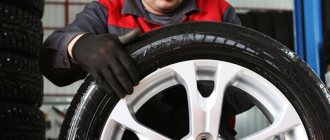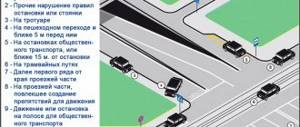When to change tires
The optimal time for seasonal tire replacement varies from year to year due to weather vagaries. And this is normal even for one city - let alone different regions, where ideas about winter and summer can differ significantly. Therefore, legislative initiatives on the forced seasonal “change of shoes” of cars in strictly defined months look rather strange: nature will still make adjustments.
An analogy with utility workers who begin and end the heating season not according to the calendar, but when a certain average daily air temperature is reached - that is, based on objective thermometer readings - is appropriate here. Motorists should follow the same approach when choosing the time to change tires.
At what temperature should tires be changed? Manufacturers believe that +7 degrees Celsius is the optimal moment for seasonal “change of shoes”. At this point, the graphs of the grip levels of winter and summer tires converge: at temperatures above +7°C, winter tires work ineffectively and wear out quickly. And at lower temperatures, the performance of summer tires drops.
But this graph reflects the properties of some average tires. In reality, the composition of the rubber mixture differs significantly between different tires. The same winter tires can be soft “Scandinavian” (Shore hardness 50–55 units), or “Central European”, with a hardness 60–65 units. Obviously, their performance differs greatly: the first ones will “float” even at a slight plus, while the second ones will work tolerably even at +10°C.
Read more: Which tires are better? Scandinavian, European, studded
The choice of temperature is also somewhat arbitrary. In a sharply continental climate, it can be +7 during the day, and -3 at night, and in the morning you will be greeted by a dangerous ice film on the road. Therefore, it is better to be guided by logic: switch to summer tires when there is no chance of encountering ice on the road. That is, if the thermometer does not go negative during the day, and the long-term weather forecast does not promise colder weather. Conversely, install winter tires before the onset of near-zero temperatures and the first frosts, which threaten to turn puddles into ice.
But still, it is the temperature, and not the presence of precipitation, that is the key signal for tire replacement. For example, at -5°C, summer tires are ineffective even on completely dry asphalt. And when the temperature rises from +4 to +11°C (just in the “transition” region of +7°C), the braking distance on winter tires immediately increases by half a meter. With the further rise in temperature, winter tires are already losing several car body lengths to summer tires in braking. Therefore, driving on winter tires in the summer is very fraught.
Read more: To inform or change shoes? Is it necessary to change winter tires to summer tires in summer?
When to change your shoes in 2021
Photo: TASS/FA Bobo/PIXSELL/PA Images
At the same time, it’s worth changing your car’s shoes not only because it’s required according to the regulations. Winter tires lose their properties on asphalt and at high air temperatures. “For example, because of the studs, a distance appears between the asphalt and the rubber itself, the car slows down worse,” explained auto expert Konstantin Ligachev.
In addition, using winter tires that are not suitable for the weather will lead to the fact that such wheels will not last long: soft winter tires on asphalt wear out much faster, and studded tires simply fall out of their studs.
Ideally, each type of winter tire should have its own weather and conditions. If the temperature is zero and the roads are cleared of snow, then regular winter tires will help you. If the road cleaning is bad, there is snow on the asphalt and porridge, then there are spikes. Dmitry Popov
independent auto expert
However, there is no need to rush to change tires either. “The worst thing during the transition period between seasons is ice. Moreover, it is not the ice itself that is dangerous – at least it is visible. The threat is posed by the so-called tongues of ice, which form where there is constant friction. Where there is temperature, there will always be ice rolled there. And these are the most potentially dangerous places - intersections, traffic lights, pedestrian crossings,” noted Vladimir Bakharev, an auto expert and chief trainer of the expert, in a conversation with Moscow 24. He added that such dangerous zones appear due to sudden, most often night frosts.
Therefore, a consistently positive temperature is important for changing tires. “And it’s better to pay attention not to the daily average, but to the nightly indicators. When the night temperature is +5 or higher for at least a week, then you can safely go to a tire service,” added Bakharev. Moreover, this rule is the same for any type of winter tires.
Yes, the weather has been warm for a long time. But you shouldn’t rush to change tires so as not to damage the wheels. The worst thing that could happen to them has already happened during this warm Moscow winter. Therefore, plus or minus three days will not change anything. Vladimir Bakharev
auto expert, chief trainer of expert
But you want to save the properties of your winter tires and decided to change your car ahead of time? Be prepared not to take a car in case of night frosts and sudden snowfalls, which are completely possible in March. Driving on ice on summer tires is extremely unsafe.
How to change tires correctly
If you bought a new set of tires, you can immediately begin installing them. But old tires, which have been waiting in the wings for six months, require certain checks.
First of all, make sure the tires are still drivable. According to the Road Traffic Regulations, the minimum permissible tread depth for passenger car tires is 1.6 mm (summer tires) and 4 mm (winter tires). With a smaller balance, you can no longer drive on tires.
You can measure the remaining tread with a special tool - a caliper. There are also special wheel tread depth meters, including digital ones.
Another important traffic regulation requirement for tires: they must be the same (at least on each axle). Modern cars, equipped with a variety of smart electronics - ABS, directional stability and braking force enhancement systems - are sensitive even to uneven tire wear, not to mention different sizes or tread patterns. But dangerous experiments by drivers with the so-called mixed tires (sets assembled from different tire models) are already becoming a thing of the past.
Also, before installation, you need to visually assess the condition of the tires. During long-term storage, especially in unsuitable conditions (for example, with high humidity, which is not uncommon in private garages), the rubber may become deformed, crack or dry out. It is impossible to install tires with such defects: at high speed, any crack in the rubber becomes extremely dangerous and threatens to explode the tire.
By the way, for seasonal tire storage you can use the “Hyperauto Tire Hotel”, where the correct temperature and humidity are constantly maintained. Hyperauto specialists bear full financial responsibility for the tires, and on the day you designate, they themselves bring the wheels to the tire shop, which is very convenient.
In addition to the tread depth and the absence of external defects, before installing the tires, you need to check the uniformity of their wear (the tire should not be “eaten” on one side), as well as their age. The natural rubber from which rubber is made retains its properties for 5 years from the date of production of the tire. The aging of rubber greatly affects the effectiveness of road grip, so you should not drive on old, even if not worn, tires.
Tire rotation when changing
When changing tires, do not forget about their periodic rotation - rearrangement, a diagram of which can be found in the instructions for the car. Rearranging the wheels ensures uniform wear, which extends the life of the entire set. Standard tire rotation patterns are presented below, but it is better to check the instructions for your specific car. It is recommended to change tires every 10,000 km.
On rear- and all-wheel drive vehicles, the front tires are moved to the rear axle diagonally (pattern A), or changed in a cross pattern (B). On front-wheel drive vehicles the situation is reversed: the rear tires are moved forward diagonally (diagram C).
Tires with a directional tread pattern cannot be rolled out without re-boarding. To rotate them without removing them from the rims, the front wheels are simply swapped with the rear wheels on each side of the car (diagram D).
If your car is equipped with a full-size spare tire rather than a spare tire, and you bought a set of five new tires, be sure to include the spare tire in the rotation (patterns E and F), rotating the wheels every 10,000 km. This will allow you to use the set longer and easily replace any of the main ones with a spare wheel in case of damage - their wear will be the same. Thanks to this scheme, buying five tires ultimately turns out to be more profitable than buying four due to longer service life.
To ensure rotation, mark the old tires with a colored marker before they are removed from the car; If you forget about this, it will be difficult to figure out where each tire was.
Differences between individual tire types
Before answering the question about the timing of replacing used tires with new tires, let’s take a closer look at the various options for car tires. The market offers a wide range of models from different manufacturers. All options can be divided into 3 main categories:
- Winter tires;
- summer tires;
- all-season.
Tires from the first group are also divided into studded and friction (so-called “Velcro”). All tires differ in their performance properties, as they have different tread patterns and a special rubber compound composition corresponding to the nature of the operation. For example, in winter it is important that the car maintains high maneuverability in deep snow, can freely drive through slush and mud, brake effectively on ice and accelerate just as quickly. In this regard, tires used in the cold season are equipped with the following characteristics:
- large blocks and deep tread;
- a large number of multidirectional lamellas in the pattern;
- the use of a compound that maintains elasticity at low temperatures.
We recommend: Wheel alignment in Mitino
Unlike summer tires, winter tires can additionally be equipped with metal toe studs. This helps maintain stability on icy roads. However, the use of spikes is not always appropriate, and in some countries it is completely prohibited. The thing is that metal inserts increase the weight of the wheel, spoil the asphalt surface and increase the noise level. Therefore, it is worth using studded winter tires in regions with a cold climate or if you often travel outside the city, where the roads are not covered with reagents and are not cleaned as often. A special marking will help you understand that you have winter tires: M&S (sometimes may be designated as M+S). This indicates that the rubber properties are designed to work in mud and snow. Additionally, the tires may have a pictogram depicting a snowflake against the backdrop of the Trek Mountains. This marking indicates that the tires are suitable for use in harsh and cold winter conditions. There is no pictogram or M+S inscription on summer tires.
You need to change summer tires to winter tires and back in a timely manner. Otherwise, fluctuations in weather conditions may take you by surprise and reduce your safety while driving. Practical drivers who want to save money on tire fitting often refuse to use winter and summer tires, and therefore prefer all-season tires. Such tires are suitable for use in warm and cold weather, but still cannot cope as effectively with ice and snow, braking on wet or dry asphalt, as their seasonal counterparts.
Foreign experience and international legal acts
The main international legal document, in accordance with which Russian bills in the field of traffic regulation and technical requirements for vehicles are developed, is the Technical Regulations of the Customs Union on the safety of wheeled vehicles
.
The regulations explain in detail the use of specialized winter tires in the winter season.
This act clearly states the purpose of the ban on the use of summer tires in the winter months - to reduce the number of traffic collisions during the cold period.
The technical standards described in the regulations have already been officially adopted.
They came into force and began to operate on January 1, 2015 on the territory of Kazakhstan and Belarus.
In order for this to happen in Russia, a law on winter tires is being prepared for adoption.
A ban on the use of summer tires in winter is in effect in many European countries with relatively cold climates.
In countries with warmer climates (Italy, Greece, etc.) this prohibition is not categorical.
Accordingly, there are no fines for violation.
Countries such as Austria or Sweden, as well as some Baltic countries, have specific deadlines during which winter tires must be used exclusively.
For example, in Latvia this period covers a whole six months - from November 1 to May 1, and in Finland - from November 1 to March 1.
In addition, the legislation of a number of countries states that the tread depth of winter tires should not be less than 3 millimeters.
You will probably be interested in looking at the OSAGO mental map, which explains in detail what to do in the event of an insured event.
Or HERE you will learn about the types of administrative offenses
Courts of general jurisdiction hear the following cases:
Normative base
Legal regulation in the field of installation and use of tires on vehicles in the summer is carried out by the following legislative acts:
- Technical regulations TR CU 018/2011 – regarding the timing of replacement of winter tires.
- Appendix 1 to Government Decree No. 1008 of December 5, 2011 - on what criteria tires must meet in order for the car owner to successfully pass inspection.
- Section 5 of the “List of faults and conditions under which the operation of the vehicle is prohibited”, contained in Government Decree No. 1090 of October 23, 1993, states that if the tires do not meet which parameters, the operation of the vehicle is prohibited.
- Chapter 12 of the Code of Administrative Offenses – on liability for non-compliance with the legislation on the use of tires.
If the spare tire is different from those already installed on the vehicle
Each car has a spare tire, which will be needed in case one of the tires has been punctured and you need to get to the nearest tire shop without resorting to a tow truck.
In clause 5.7.4. Technical regulations TR CU 018/2011 say that different tires (winter and non-winter, for example) cannot be installed on the same axle. However, the requirements of this paragraph do not apply in the case of temporary installation of a spare wheel on the vehicle.
In this case, it is important whether the “spare tire” is on winter tires or summer tires (since the note to clause 5.7.4. applies only to this clause). That is, “seasonality” must correspond. For example, you cannot install a spare tire in the summer if it (theoretically) has anti-skid studs (but there will be no fine for this).
In clause 5.5. “The list of faults and conditions”, which contains a similar rule about the inadmissibility of installing different tires on one axle, there is no such note about the “spare wheel” as in the Technical Regulations TR CU 018/2011. Therefore, it remains unclear whether or not the driver will be able to be charged under Part 1 of Art. 12.5. Code of Administrative Offenses specifically for the temporary use of a spare wheel that is different in size or other characteristics from those already installed on the vehicle (for the out-of-season “spare wheel,” as we have already indicated, there are no fines).
Current legislature
The latest amendments to the legislation and technical regulations of the Customs Union were made in 2021, if we talk about the issue of operating seasonal tires. That’s why there were no innovations in 2021 or in 2021.
If you study this document, you can draw several main conclusions.
- Summer. This refers to the summer months from June to August. According to the rules, the car should not have winter studded tires at this time. It is forbidden. Here it would be logical to recall the material where I discussed spikes and Velcro;
- Winter. This is the period from December to February. Drivers are required to use only winter tires that bear the MS mark and a badge that shows a snowflake;
- Local authorities. All drivers in Russia cannot be brought under one rule. Indeed, in Crimea and the Krasnodar Territory, for example, weather conditions differ from those observed in St. Petersburg, the Rostov region, the Orenburg region or Volgograd, for example. At the local level, decisions are made regarding extending the service life of different types of tires. This is due to differences in climate. In this case, the regional leadership can only extend the period. But they cannot reduce generally accepted norms.
We recommend: How to properly check oil scraper rings and what is needed for this?
Winter Velcro or studded tires should be used during the period when summer tires are not able to cope with possible icing of the road surface. Equally important is the quality of the selected kit. Here I want to remind you about the material about Chinese tires.
Practical application of laws
Switching to new tires or tires that have been used for 1-2 seasons in a timely manner is important for your personal safety. It’s not difficult to imagine what usually happens when a car ends up with summer tires during cold weather. There are many videos with similar extreme sports. Although here I would focus on people’s lack of common sense.
It follows from the regulations that a motorist can use studless winter tires throughout the year. This is not allowed with spikes.
If the period of the year is warm and the car is shod with summer tires, then the transition to winter tires should be carried out between September and March. In the opposite direction, the operation is carried out from March to May. It all depends on how quickly warming or cooling occurs specifically in your region.
I will give several examples in specific cities.
- Moscow. Winter tires must be installed from October 15 to October 25. The transition to summer tires is regulated from April 10 to April 16;
- Novosibirsk Winter wheels should be installed from October 12 to the 17th of the same month. And to change the winter set to the summer set the period is given from April 24 to April 30.
- Perm (and the entire Perm region). Winter kits are delivered from October 12 to October 17. You should return for summer from April 17 to April 24.
These are conditional and deadline dates, since most sensible people switch to winter tires earlier, but are in no hurry to return to warm sets. Winter often drags on, the temperature during the day can be quite high, but at night the roads still freeze. Because of this, riding kits for the warm season is potentially dangerous.
When is it legal to install winter tires in 2021?
The law does not provide for a specific period during which tires must be replaced, but it does prohibit the use of a certain type of tire in certain months:
- from June to August it is prohibited to drive on studded tires;
- From December to February it is prohibited to drive without winter tires.
Important nuance! The technical regulations of the Customs Union are an international document. Clause 5.5, regulating the seasonality of rubber, gives countries belonging to the Union the opportunity to independently change the established deadlines in accordance with their climatic conditions. The Russian federal government, in turn, transfers these powers to the authorities of its constituent entities, since due to the geographical location and size of the country, even within its borders, climatic conditions vary significantly.
Because of this note, a rumor arose in Russia about the existence of a certain law on changing car tires. Indeed, regional authorities can extend bans on the use of studded or summer tires if this is due to the climatic conditions of the region. But no law sets a time limit during which all motorists must change the type of tire.
To find out about changes in the terms of restrictions on the use of certain types of tires, you need to go to the regional traffic police website and check for announcements in the news block. If the necessary information is not there, you can send an electronic appeal or simply call the number of the regional division of the State Traffic Inspectorate.
- Car loans
- All about OSAGO
- All about CASCO
- Car insurance
- Car taxes
- Road accident - what to do?
- All about carsharing
- Fines
- Registration actions
- Communication with the traffic police
- To help drivers
When is it time to change summer tires to winter ones?
According to traffic regulations, the use of summer tires in winter is strictly prohibited. The technical regulations of the Customs Union force motorists to put winter tires on their cars before December 1 - the norm is relevant for all regions of the Russian Federation
It is important to note that time frames may vary further for individual areas. For example, in Moscow and surrounding regions in 2021, local authorities have set a mandatory transition date of November 1. For Siberia, where sub-zero or near-zero temperatures are typical even in summer, snow tire models are used all year round.
Penalty for summer tires in winter in 2020-2021 in Russia
The situation with trucks is different. Until recently, changing tires to summer tires was mandatory for everyone.
In 2021, an amendment was made to the Technical Regulations, which allowed freight transport (except M1 and N1) not to install winter tires.
It allows you to ride one set, if it remains in satisfactory condition, all year round. However, it is still necessary to change winter tires to summer tires.
Let's consider paragraph 5.5 of Appendix 8 to the technical regulations of the customs union TR CU 018/2011 “On the safety of wheeled vehicles”:
It is prohibited to operate vehicles (vehicles) equipped with tires with anti-skid studs in the summer (June, July, August).
During the winter period (December, January, February), the operation of vehicles of categories M1 and N1 that are not equipped with winter tires that meet the requirements of clause 5.6.3 of this appendix is prohibited. Winter tires are installed on all wheels of the specified vehicles.
A period different from that specified in paragraph one of this paragraph may be established by the legislation of a member state of the Eurasian Economic Union in connection with climatic and geographical factors characteristic of member states of the Eurasian Economic Union.
- In the summer months (June, July, August) it is prohibited to use only “studded” tires - This requirement applies to all vehicles;
- During the winter months (December, January, February) it is allowed to use only “winter” tires. You can put both “studded” and non-studded tires on your car. It is important that they are marked “M+S”, “M&S” or “MS” and the corresponding drawing (in the picture on the left). The requirement applies only to category B vehicles (M1 cars and N1 trucks). The restriction does not apply to other vehicles from November 11, 2018;
- The terms of the prohibition of operation can only be increased by the legislative authority of any level (federal, regional) and cannot be reduced, that is, in your region they may, for example, prohibit the use of “studded” tires from May to September, while regional authorities cannot reduce the period ban, that is, from June to August, cars in all regions should not use studs.
Many car owners in Belarus still do not know that on January 1, 2015, the Technical Regulations of the Customs Union “On the safety of wheeled vehicles” came into force. This law contains Appendix No. 8, which regulates the seasonality requirements for tires. According to this document, during the winter months (December, January and February) winter tires must be installed on passenger cars participating in road traffic. Since the Republic of Belarus is a member of the Customs Union, this rule also applies on the territory of our country. The corresponding changes were made to the traffic rules in 2014 and came into force on 01/01/2015.
That is, according to the law, no later than December 1, the car must be changed to winter tires, and from March 1, it is allowed to change them to summer tires. So, from December 1, 2021, don’t expect mercy, the State Traffic Inspectorate is actively fining summer and “bald” tires for violating traffic rules. You will find information about the amount of fines below .
In what month should you install winter tires?
All drivers should know when it is legal to put on winter tires. But a lot also depends on the region, and there is even a provision in the law that allows local authorities to regulate this issue in one direction or another. Drivers should also not increase or decrease the temperature on their own.
We recommend: Pandora alarm system: operating instructions for all models
For example, if the temperature constantly stays around 7-9 degrees Celsius, then there is no point in changing tires to winter ones. The tires will quickly wear out, and their soft structure will not allow you to maneuver the car with high quality. If the temperature is too low, the driver may suffer in an accident, since the slippery road will not provide the opportunity to react in time to various emergency situations, reduce the braking distance or make a maneuver.
So, in what month should you install winter tires? This usually occurs in November, although, again, it all depends on climatic conditions and the region. If we focus on other circumstances, then the following features are taken into account: the car is constantly in use - you will have to replace winter tires earlier, when the temperature is 6-8 degrees; The car is used irregularly, then you can change the tires even at 0 degrees, if traveling by public transport or in a taxi does not bother you.
What tires to install in winter in Moscow
The selection of tires for a car is always determined by the purely personal preferences of the car enthusiast.
But there are a number of recommendations to improve cross-country ability and minimize tire wear. For the correct selection, first of all, the quality of the road surface is taken into account. If in 90% of cases the car drives on a cleared, asphalt road, where there is no heavy ice or heavy snowfall, you can install standard friction models. Such rubber does not make noise and clings well to compacted snow at sub-zero temperatures.
In case of frequent trips to snowy areas or rural areas where there is virgin snow, it is recommended to install a studded version. Metal elements will increase cross-country ability and minimize braking distances on crusts. Also, the reinforced tread quickly removes loose snow off-road.
Additionally, the location of the drive wheels should be taken into account. If the car is rear-wheel drive, the tires should be the most grippy. The pushing pair will easily slip on ice. You can save money on front-wheel drive cars. Due to the greater load on the drive axle, the wheels are pressed harder, which improves control and maneuverability.
But there are requirements for any type of rubber
And they are already stated directly and clearly in the Rules of the Road, specifically in the List of conditions under which the operation of a car is prohibited. This application has a whole section containing a list of faults that prevent you from driving your car on public roads.
Wear
For summer and winter tires, different levels of possible wear apply, at which you cannot drive.
For “summer” you can’t drive on tires with the following tread depth:
- less than 0.8 mm for motorcycles, scooters and mopeds,
- less than 1 mm for trucks over 3.5 tons and trailers for them,
- less than 1.6 mm for passenger cars and trucks less than 3.5 tons and trailers for them,
- less than 2 mm for all types of buses (with more than 8 seats).
But for winter there is no division into categories of cars - the permissible wear for them is the same - at least 4 mm, and here it no longer matters whether you have spikes. Therefore, if the wear of winter tires is less than 4 mm, then they need to be replaced with summer tires, unless, of course, your summer tires comply with traffic regulations for wear.
Damage
It is also prohibited to drive a vehicle whose tires have operational defects, including the following:
- torn damage and cuts (including side ones), if the rubber cord is visible,
- peeling in the tread area,
- peeling on the side,
- punctured tires.
Different tires
You cannot ride on wheels in the following cases, when the tires on them are different on the same axle (one at the front or rear on the left, another on the right):
- by size (radius, profile width and height),
- by design (radial and diagonal),
- one with a camera, the other - tubeless,
- different models,
- along the tread.
It is also important to know that it is prohibited to use wheels with different tires based on the presence of studs: if all are studless and at least one with studs, and vice versa.
Does not match the vehicle
And the last prohibition is if the tires do not match the car in terms of load or size.
How will the inspector determine the wheel size? Everything is very simple. If, for example, you install 16-radius wheels on a Lada Granta, the inspector may issue a fine under Part 1 of Article 12.5 of the Code of Administrative Offenses of 500 rubles, since the design of the model does not provide for such tire sizes.
Same with the load. The table for the correspondence of the load index to the vehicle weight is contained in Table 5.2 of the regulations.
Thus, if you have winter tires, at least one of the parameters of which does not comply with traffic regulations, then you need to switch to summer tires by law, if the latter is new enough and the same enough to satisfy all the above conditions. Otherwise, the only thing left to do is buy new tires.
After how many seasons should summer tires be changed?
Modern summer tires last 5-6 years with average use.
In 90% of cases, the question of replacement arises due to wear of the tread part, if there is no serious damage to the cord or cuts. With low mileage, some copies can withstand up to 15 years of continuous use. The exact figure depends on the quality of the tires and driving style. The time for changing tires is not tied to the season - the parameter is determined by mileage. For passenger cars such as Chevrolet Cruze, Lada Granta, Opel Vectra, the service life of one set is limited to approximately 50,000-60,000 km. mileage On trucks, tires last longer, on average up to 70,000 kilometers.
The parameters are relevant for high-quality tires with careful driving, in the case when the car does not have problems with the chassis (the wheel alignment is knocked down, the suspension elements, the body are damaged). Depending on the severity of the breakdown, the service time is reduced.
Special indicators on the working surface will help you find out when you should replace your tires with a new set. On 80% of models there are special inserts between the studs.
If the rubber has worn down to them, further use is not recommended. Also, some modifications have serifs in the form of numbers on the working surface. When the sign is no longer readable, the tires have worn out.
If these elements are missing, it is necessary to measure the remaining tread height. The procedure is done in several places, with a special tool or caliper. If the remaining studs are less than 1.6 mm, further operation on a passenger car, according to traffic regulations, is prohibited.
Choosing a tire shop
If you have experience, tools and certain skills, you can change tires yourself. But it’s easier to contact tire fitting specialists. For little money they will quickly and efficiently replace tires. In order not to make a mistake when choosing a service, you should pay attention to the following points:
- availability of tire manufacturer certificates;
- quality of tools and organization of their storage;
- approach to the work (for example, the responsible foreman uses a dynamic wrench to check the tightness even after working with a wrench);
- how is communication with the client conducted, do specialists answer all questions;
- price does not always indicate the level of service;
- reviews from friends and on the Internet;
- It may be easiest to contact an authorized dealer to carry out the work.
Pressure and balancing
If a replacement set of wheels is mounted on separate rims, check the pressure in them before installing them on the vehicle. If a tire deflates during storage, look for the reason - the air does not just go away. Under the weight of the car, the air leak will only intensify, and the next morning after “re-shoeing” you will have a flat tire waiting for you if you don’t fix it in advance.
Do not forget that the pressure in tires of different sizes may vary - do not inflate the old one after getting used to it in six months. Look for the recommended pressure values for different tire sizes on the sticker in the doorway.
Don’t forget about the importance of wheel balancing: it ensures uniform rotation, absence of vibrations on the steering wheel and body, and also protects the life of wheel bearings. Each wheel of the car needs balancing, including the spare one - in case of emergency installation on the road, as well as for planned tire rotation.
Even if you use two sets of wheels on different rims, check the balance of each before installation. Over the course of a season, the tire tread wears out (not always evenly), and installed weights often fall off—as a result, the wheel’s balance may be disrupted.
Several reasons to change tires in advance
When to change tires to winter ones in 2021 is up to you to decide; we will only outline the obvious reasons why it is better to do this earlier.
- Preparedness for sudden changes in weather conditions
When you change your tires to winter ones in advance, you insure yourself against the vagaries of the weather. You can safely leave the yard in the morning, even with an unexpected overnight snowfall. At the same time, your neighbors will try to get out of the parking lot on summer tires or frantically change plans and call a taxi service.- Queues at the tire shop Every year after the first snowfall, a line of people line up at the tire shop to change their tires to winter ones. Typically, 90% of car enthusiasts put off changing tires until the last minute, creating an unhealthy rush at the first signs of real winter. To avoid wasting time standing in line, it is better to change your tires in advance.
- Breaking in a new set of winter tires After installing a new set of winter tires (especially models with studs), you need to break them in. This means that for approximately the first 100 km, it is important to avoid slipping and emergency braking. It is better to move at a speed of no more than 80 km/h. Experts recommend changing tires and running them in before the first snow falls.
Consequences of untimely replacement of winter tires
In addition to fines, sluggish vehicle owners will face a lot of negative consequences. If you use winter tires in summer, you may encounter the following difficulties:
- rapid tread wear;
- increased fuel consumption;
- poor vehicle handling on dry roads.
Summer tires in winter even increase the risk of getting into an accident. These tires are not designed for driving on ice and snow; they instantly harden even in light frost and lose traction on wet and dry roads.
We recommend: How to properly bleed the brakes - all the nuances, procedure
A powerful car can offset the negative consequences of installing inappropriate tires, but still, correctly selected tires will help not only increase the level of safety, but also unlock the full potential of the vehicle. As for fines for incorrectly installed tires, they are small. In most cases, you can get away with a warning. However, the traffic police inspector may impose a fine of 500 rubles.
Winter tire law
So, the full official name of the document, commonly called the law on winter tires: Federal Law “On Amendments to Certain Legislative Acts of the Russian Federation (to ensure safety during the operation of vehicles)
».
The Federal Law was submitted to the lower house of parliament on March 3, 2014 and registered under number 464241-6.
Theoretically, the law should have come into force on January 1, 2015, but this did not happen.
It is difficult to say exactly when it will begin to take effect, but we should definitely expect this event at the beginning of the year.
As mentioned earlier, the document that establishes the requirements for vehicles is the Technical Regulations of the Customs Union on the safety of wheeled vehicles.
For this reason, all national regulations in the field of safety requirements for motor vehicles must be brought into line with it.
Since the regulations indicate the mandatory use of winter tires in winter, we should expect final approval of the law on winter tires in the near future.
In accordance with this act, the winter period will last exactly all 3 winter months, from December 1 to March 1.
But climatic conditions in different regions of Russia differ, so this period in certain regions of the federation can be extended.
True, it can no longer be reduced - 3 months will remain the minimum period.
The bill provides for amendments to the Code of Administrative Offenses regarding penalties.
When the law comes into force, violators will have to pay a fine of 2,000 rubles for using bald tires in winter.
Is there a fine for driving in winter on summer tires?
Today in Russia there is no regulation on whether to change summer tires, so motorists need not be afraid of fines for using off-season tires in winter - there is simply no such type of punishment. There are also no sanctions for using the “wrong” tires. Car owners must assess the weather conditions themselves, take into account the average daily temperature and decide when to replace summer tires. There are only recommended dates when to change winter tires in Russia. For the middle zone, this is November 15 and March 15 for changing summer and winter sets, respectively.
Of course, you need to focus primarily on common sense, and not the onset of a specific date. Depending on the region of the Russian Federation, weather conditions may vary greatly. Drivers must decide whether to change tires based on the actual, rather than calendar, seasons. If there is snow in the first days of March, then there is no point in changing the set to a summer one. And if in warm regions - for example, Crimea or Sochi - it was a sunny and dry November or even December, then car enthusiasts will not think of urgently changing their tires to winter ones.
You will not receive a fine even if your car has summer tires during the winter months of the direct ban: December, January, February. However, there is another penalty that can be applied in case of insufficient projector depth on both summer and winter tires.
Among car enthusiasts, there is an expression about driving on “bald tires” - those where the tread is almost completely worn out. Driving on such tires is dangerous and they need to be changed. Under the new rules, driving on bare tires is punishable by a warning or, more likely, a fine. According to the traffic rules, if a vehicle does not meet the requirements, then it should not be used for transportation. The remaining height of the tire tread pattern is indicated in the regulations on the vehicle's approval for operation.
This value should not be:
- for trucks - less than 1 mm;
- for passenger cars - less than 1.6 mm;
- moped, motorcycle - less than 0.8 mm;
- bus - less than 2 mm.
If a traffic police officer discovers a violation of this rule, he has the right to issue a fine of 500 rubles in accordance with Art. 12.5 COAP.
Now deputies are discussing the possibility of increasing the fine for driving on “bald” tires by 4 times. This position seems quite justified - given that a significant proportion of accidents occur in winter, when the roads are often icy, due to the fault of drivers using worn out tires.
When to change tires to summer tires in 2021 according to the law
- Calculate transport tax
- Calculate OSAGO
- Calculate CASCO
- Calculate car loan
- Calculate fuel consumption
- Car customs clearance calculator
As stated earlier, the question of when it is possible to change a car’s shoes to summer tires is regulated by the Technical Regulations of the Vehicles in section 5 it states that:
- Vehicles must be equipped with tires that are recommended by manufacturers for the climatic conditions of the country;
- The tire dimensions must match the car's rims;
- load and speed indices must correspond to the maximum characteristics of the car, which are specified in the technical documentation for the vehicle. For example, the speed index H means that the maximum permissible speed of a car is 210 km/h. Load index 82 means that the maximum load on one wheel is 475 kg;
- The tread height of a summer set of tires should not be lower than 1.6 mm for passenger cars and trucks up to 3.5 tons. For buses the indicator should be at least 2mm, for motorcycles 0.8mm. Regarding trucks and trailers weighing more than 3.5 tons, the minimum tread is 1 mm;
- It is prohibited to operate tires with various damages. These include punctures, cuts, delamination of tires and destruction of the material up to exposure of the cord.
Russia is part of the customs union. When is it legal to put on winter tires in the capital and region?
Since January 2015, technical regulations allow the use of summer tires in Moscow and central Russia from March to November.
Studded tires are allowed to be used from September to May. On all-season, studless Velcro, it is possible to move on central roads all year round.
In the southern regions of Russia there is often wet snow and snow crumbs, in which Velcro behaves better. A studded tire handles well on snowy roads, while a Velcro tire is more effective on wet asphalt.
Therefore, in Krasnodar, Sochi and the region it is recommended to use all-season tires, which do not need to be changed with the onset of calendar winter. You can travel on these tires all year round.
Studded tires are not recommended for use in these areas. Spikes ruin wet asphalt. Tires designed for severe frosts wear out faster in warm winters. Traffic police officers can fine a driver 500 rubles for driving on an icy or snowy road on bald tires with a tread depth of less than 4 millimeters.
What else to do when changing tires
Whenever dismantling wheels, it is worth carrying out a quick inspection of the suspension parts, checking the condition of the brake hoses and the thickness of the brake pads. In general, it is useful to combine seasonal tire changes with chassis diagnostics: it is better to identify any unpleasant surprises in advance.
After changing tires, be sure to adjust the wheel alignment angles (“wheel alignment”), because winter and summer tires differ in height, tread pattern, and degree of wear; often - by dimension and pressure. All these factors disrupt the suspension geometry, which can lead to uneven tire wear, increased fuel consumption, uneven steering wheel position and vehicle pull to the side.
To avoid these problems, it is better to change tires where you can immediately adjust the camber and toe. For example, in Hyperauto service centers, equipped with separate tire fitting areas.
Recommendations for replacing tires with summer tires
A frequent question from car owners is “what should the air temperature be to replace tires with summer tires?” Manufacturers recommend focusing on plus 5 Celsius, which will remain stable for some time. However, there are nuances, because spring never comes overnight.
You should not change to summer tires if:
- Frosts still occur at night;
- trips out of town, etc. are not uncommon;
- there is snow or ice on the road;
- the driver’s path runs where the road dries out later than in other places;
- The machine is mainly used very early in the morning and/or late in the day.
In these conditions, it is probably worth waiting for a more stable high temperature, otherwise summer tires will harden in cold weather, which will significantly reduce driving safety (driving a car on such tires is harder).
At the same time, you shouldn’t delay too much with replacing wheels. If the average daily temperature is around o, it’s time to change the tires to summer tires, because winter tires will wear out and the car will “eat” more fuel.
It is impossible to say the exact date of tire replacement, because spring comes to our latitudes differently every year. You need to change wheels based on weather conditions and personal experience.
At what temperature can you legally change winter tires to summer tires?
The laws and traffic regulations of the Russian Federation do not limit motorists in terms of ambient temperature - this is done by the composition of the tires. Winter tires are designed in such a way that when they heat up, their driving performance decreases. In the summer, the car begins to wear on snow tires, the tread quickly wears out, and the braking distance increases.
Negative factors begin to appear already at the threshold of +7+10 degrees Celsius. Thus, it is necessary to install summer tires when the snow has completely melted and stable weather has established with a positive air temperature.
Expert advice on replacing winter tires
From year to year, the seasons change at different times, which confuses car owners. Many vehicle drivers rely on specific weather conditions when changing tires. Thus, experts recommend removing winter tires when the temperature is above +7 degrees. It’s good when the daily average reaches +10 degrees. At this time, the risk of night frosts is minimized, which means you can install summer tires that will last until August, or even until the end of October.
According to statistics, in 2021, car owners began changing tires to summer tires in April. The peak of calls to tire service centers occurred on the weekend of the 14th-15th. In 2021, this deadline shifted by a week, as the winter was quite snowy. In 2020, it was possible to change shoes in March. The winter was not rich in precipitation, and the temperature in a number of regions rose above +5 degrees by the end of February. To save money, some auto experts recommend changing the wheel assembly. This will help avoid damage to the rim and cord during storage in the summer or winter months, and will also reduce costs, since you will have to go to tire service centers much less often.
Sources
- https://HyperAuto.ru/articles/poleznaya-informaciya/sezonnaya-pereobuvka-kogda-i-kak-menyat-shiny/
- https://BlackTyres.ru/informaciya/informatsija-o-shinah/kogda-menjat-shiny-na-zimnie/
- https://bostonauto.ru/text-livehuck/pravila-zameny-zimney-reziny-na-letnyuyu-v-2020-godu/
- https://Shinomontazh-Penza.ru/to/kak-ezdit-na-shipovannoj-rezine-zimoj.html
- https://tvoikolesa.com/kogda-nado-stavit-zimnyuyu-rezinu/
- https://AutoTonkosti.ru/q/kogda-nuzhno-perehodit-na-letnyuyu-rezinu-s-zimney-po-novomu-zakonu
- https://rad-star.ru/pressroom/articles/kogda-menyat-rezinu-na-letnyuyu/
- https://rad-star.ru/pressroom/articles/kogda-menyat-rezinu-na-zimnyuyu/











